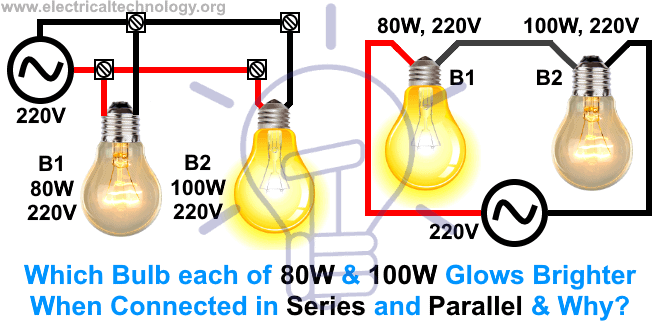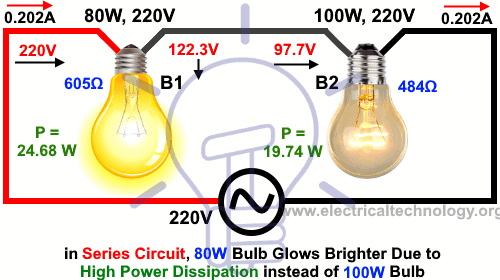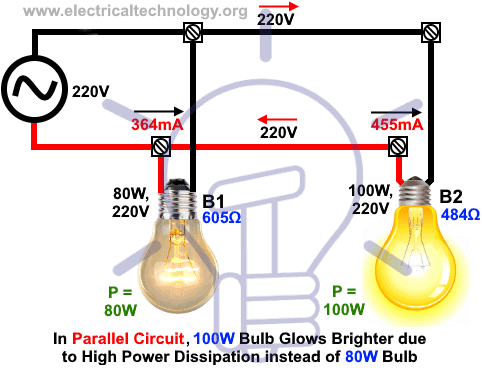Which Bulb Glows Brighter When Connected in Series and Parallel & Why?
Two Bulbs of 80w and 100w are Connected in Series and Parallel. Which One Will Glow Brighter and Why?
The most confusing question we’ve received is: if two bulbs are connected in series and then in parallel, which one will glow brighter, and what are the exact reasons? Well, there is a lot of information available online, but we will provide a very detailed, step-by-step explanation to calculate the exact values and clear up any confusion.
Firstly, it’s important to note that the bulb with higher resistance, which dissipates more power in the circuit (regardless of whether it’s in series or parallel), will glow brighter. In other words, the brightness of the bulb depends on the voltage, current (V × I = Power), and resistance.
Also, remember that power dissipated in watts is not the unit of brightness. The unit of brightness is lumens (denoted by lm, which is the SI derived unit of luminous flux), also known as candela (the base unit of luminous intensity). However, the light brightness is directly proportional to the bulb’s wattage. This means that a bulb using more wattage will glow brighter.
Related Posts:
- Why Does the High-Wattage Bulb Glow Dimmer in a Series Circuit?
- Why Does the High-Wattage Bulb Glow Brighter in a Parallel Circuit?

When Bulbs are Connected in Series
Ratings of bulbs Wattage are different and connected in a series circuit:
Suppose we have two bulbs each of 80W (Bulb 1) and 100W (Bulb 2), rated voltages of both bulbs are 220V and connected in series with a supply voltage of 220V AC. In that case, the bulb with high resistance and more power dissipation will glow brighter than the other one. i.e. 80W Bulb (1) will glow brighter and bulb (2) of 100W will dimmer in series connection. In short, In series, both bulbs have the same current flowing through them. The bulb with the higher resistance will have a greater voltage drop across it and therefore have a higher power dissipation and brightness. How? Let see the below calculations and examples.
- Related Post: Why is Earth Pin Thicker and Longer in a 3-Pin Plug?
Power
P = V × I or P = I2 R or P = V2/R
Now, the resistance of Bulb 1 (80W);
We know that current is same and voltage are additive in a series circuit but the rated voltage of bulbs are 220V. i.e.
Voltage in series circuit: VT = V1 + V2 + V3 …+ Vn
Current in series circuit: IT = I1 = I2 = I3 …In
Therefore,
R = V2 / P80
R80W = 220V2 / 80W
R80W = 605Ω
And, the resistance of Bulb 2 (100W);
R = V2 / P100
R100W = 220V2 / 100W
R100W = 484Ω
Now, Current;
I = V/R
= V / (R80W + R100W)
= 220V / (605Ω + 484Ω)
I = 0.202A
Now,
Power dissipated by Bulb 1 (80W)
P = I2R
P80W = (0.202A)2 × 605Ω
P80W = 24.68 W
Power dissipated by Bulb 2 (100W)
P = I2R100
P100W = (0.202A)2 × 484Ω
P100W = 19.74 W
Hence, proved power dissipated P80W > P100W i.e. Bulb 1 (80W) is greater in power dissipation than bulb 2 (100W). Therefore, the 80W bulb is brighter than 100W bulb when connected in series.
You may also find the voltage drop across each bulb and then find the power dissipation by P = V × I as follows to verify the case.
V = I × R or I = V/R or R = V/I … (Basic Ohm’s Law)
For Bulb 1 (80W)
V80 = I × R80 = 0.202A × 605Ω = 122.3V
V80 = 122.3V
For Bulb 2 (100W)
V100 = I × R100 = 0.202A × 484Ω = 97.7V
V100 = 97.7V
Now,
Power dissipated by Bulb 1 (80W)
P = V280/R80
P80W = 122.32V / 605Ω
P80W = 24.7 W
Power dissipated by Bulb 2 (100W)
P = V2100/R100
P100W = 97.722V / 484Ω
P100W = 19.74 W
Total Voltage in the series circuit
VT = V80 + V100 = 122.3 + 97.7 = 220V
Again proved that 80W bulb is greater in power dissipation than 100W bulb when connected in series. Hence, 80W bulb will glow brighter than 100W bulb when connected in series.
- Related Post: Why is the Grounding Wire Bare and Not Insulated?

When Bulbs are Connected in Parallel
Ratings of bulbs Wattage are different and connected in the parallel circuit:
Now we have the same two bulbs each of 80W (Bulb 1) and 100W (Bulb 2) connected in parallel across the supply voltage of 220V AC. In that case, the same will happen i.e. the bulb with more current and high power dissipation will glow brighter than the other one. This time, 100W Bulb (2) will glow brighter and bulb 1 of 80W will dimmer. In short, In parallel, both bulbs have the same voltage across them. The bulb with the lower resistance will conduct more current and therefore have a higher power dissipation and brightness. Confused? as the case has been reversed. Let see the below calculations and examples to clear the confusion.
Power
P = V × I or P = I2 R or P = V2/R
Now, the resistance of Bulb 1 (80W);
- Related Post: What are the Tiny Cylinders in Power Cords and Cables?
We know that voltages are the same in the parallel circuit and the rated voltage of bulbs are 220V. i.e.
Voltage in Parallel Circuit: VT = V1 = V2 = V3 …Vn
Current in parallel circuit: IT = I1 + I2 + I3 …In
Therefore,
R = V2 / P
R80W = 220V2 / 80W
R80W = 605Ω
And, the resistance of Bulb 2 (100W);
R = V2 / P
R100W = 220V2 / 100W
R100W = 484Ω
Now,
Power dissipated by Bulb 1 (80W) as voltages are same in a parallel circuit.
P = V2/R1
P80W = (220V)2 / 605Ω
P80W = 80 W
Power dissipated by Bulb 2 (100W)
P = V2/R2
P100W = (220V)2 / 484Ω
P100W = 100 W
Hence, proved P100W > P80W i.e. Bulb 2 (100W) is greater in power dissipation than bulb 1 (80W). Therefore, the 100W bulb is brighter than 80W bulb when connected in parallel.
To verify the above case, You may also find the current for each bulb and then find the power dissipation by P = V × I as follows. We used the rated voltage of the bulb which is 220V.
I = P / V
For Bulb 1 (80W)
I80 = P80 / 220V = 80W / 220V = 0.364A
I80 = 0.364A
For Bulb 2 (100W)
I100 = P100 / 220V = 100W / 220V = 0.455A
I100 = 0.455A
Now,
Power dissipated by Bulb 1 (80W) as voltages are same in the parallel circuit.
P = I2R1
P80W = 0.3642A × 605Ω
P80W = 80 W
Power dissipated by Bulb 2 (100W)
P = I2R2
P100W = 0.4552A × 484Ω
P100W = 100 W
Total Current in the parallel circuit
IT = I1 + I2 = 0.364A + 0.455A = 0.818A
Again proved that 100W bulb is greater in power dissipation than the 80W bulb when connected in parallel. Hence, 100W bulb will glow brighter than 80W bulb when connected in parallel.

Without Calculations & Examples
Calculations and examples are for newbies. To make it simple, keep the fact in mind that always, The bulb with a “high power” will have “less resistance”. The filament of the bulb with a high rating is thicker than the lower wattage. In our case, the filament of the 80W bulb is thinner than the 100W bulb.
In other words, 100 Watt bulb has less resistance and 80 Watt bulb has a high resistance.
When bulbs connected in Series
We know that current in a series circuit is same at each point mean both bulbs getting the same current and voltages are different. Obliviously, the voltage drop across higher resistance bulb (80W) will be more. So the 80W bulb will glow brighter as compared to 100W bulb connected in series because the same current is flowing through both of the bulbs where the 80W bulb has more resistance due to lower wattage as the filament is thinner means it dissipates more power (P=V2/R where power is directly proportional to the voltage and inversely proportional to the resistance) and produce higher heat & light than the 100 W bulb.
When Bulbs are connected in Parallel
We also know that voltage in a parallel circuit is the same at each section which means both of the bulbs have the same voltage drop. Now more current will flow in the bulb which has less resistance which is 100W bulb this time which means 100W bulb dissipate more power than 80W bulb (P=I2R) where current and resistance are directly proportional to the power. Hence, 100W bulb will glow brighter in a parallel circuit.
Related Posts:
- Introduction to Series, Parallel and Series-Parallel Connections
- Series, Parallel and Series-Parallel Connection of Batteries
- Difference Between Series and Parallel Circuit – Comparison
How to know if Bulbs are Connected in series or Parallel?
Most of the household electrical wiring & installation are wired in parallel or series-parallel instead of series as parallel wiring has some advantages over a series wiring. So we may notice that higher rated bulb glows more brightly as compared to lower wattage rated bulbs. In that case, 100W bulb glows more brightly than 60W or 80W bulb.
Now, You should know that the light bulb with higher power rating will glow brighter when connected in parallel and the light bulb with less power rating will glow brighter in case of series wiring and Vice versa.
Related Posts:
- Why Do Prongs in Electrical Plugs Have Holes in Them?
- Why are US Homes Wired Using Solid Wire rather than Stranded Wire?
- Why 3-Phase Power? Why Not 6, 12 or More for Power Transmission?
- What are the Different Colors Electrical Outlets Used for?
- Why are Outlets and Receptacles in Hospitals Upside Down?
- How to Find the Number of Lights on a Single Circuit Breaker?
- How to Find the Number of Outlets on a Single Circuit Breaker?
- Will I Get an Electric Shock If I Touch the Ground Wire?
- Can the Neutral Wire Cause Electric Shock? Different Cases
- Will a Man Get an Electric Shock If He Hangs on a Live Wire?
- How To Wire Switches In Series?
- How To Wire Switches in Parallel?
- How To wire Lamps in Series?
- How To Wire Lamps in Parallel?







But what’s about leds. Is this eqally applicable for leds ?
Pls tell me.
LEDs are current-operated devices (diodes) and as such only drop a certain voltage across them (.7 – 1 volt typically for small diodes.) They need an external current-limiting device such as a resistor or they will immediately go into thermal runaway and burn out.
thanks alot for your support
REALLY helped. Great job!!
Voltage in series circuit: VT = V1 = V2 = V3 …Vn
* Voltage in series circuit: VT = V1 +V2 +V3 +…Vn
just correct this error in typing in above article
We know that current is same and voltage are additive in a series circuit but the rated voltage of bulbs are 220V. i.e.
Voltage in series circuit: VT = V1 = V2 = V3 …Vn
The above expression is wrong
is should be : VT = V1+ V2 + V3 …Vn
As mentioned, Voltage are additive in series circuit, so it is a typo which is corrected now. Any way, Thanks for the attention.
please reply
why are both 80w and 100w bubs in series connection having voltage of 220
arent devices connected in series required to split the total voltage , then how can it be said that both bulbs have 220V
thanks a lot. it was really helpful
This is not a base-level question, so think beyond the explanation above. And by the way I don’t have a good answer.
re: lightbulbs in series. A bulb’s resistance increases proportional to temperature, so as a bulb heats up, its increasing resistance acts as an automatic current limiter. With multiple bulbs in series, why does not the highest-resistance bulb not get hotter and hotter until it fails, with the other bulbs getting colder and colder as the first bulb’s resistance keeps going up and reducing current to them?
I am thinking that as the filament gets hotter, it radiates more heat, limiting its temperature to an equilibrium point. Ditto for the lower-resistance bulbs, whose equilibrium point is at a lower temperature. Thoughts?
I have a question . My house has parallel connection but still all the bulbs glow at their full brightness even though they are different watt and ratings?? Why is that ? Thanks plz answer.
Thank you so much for this detailed answer. It made my all confusions clear.